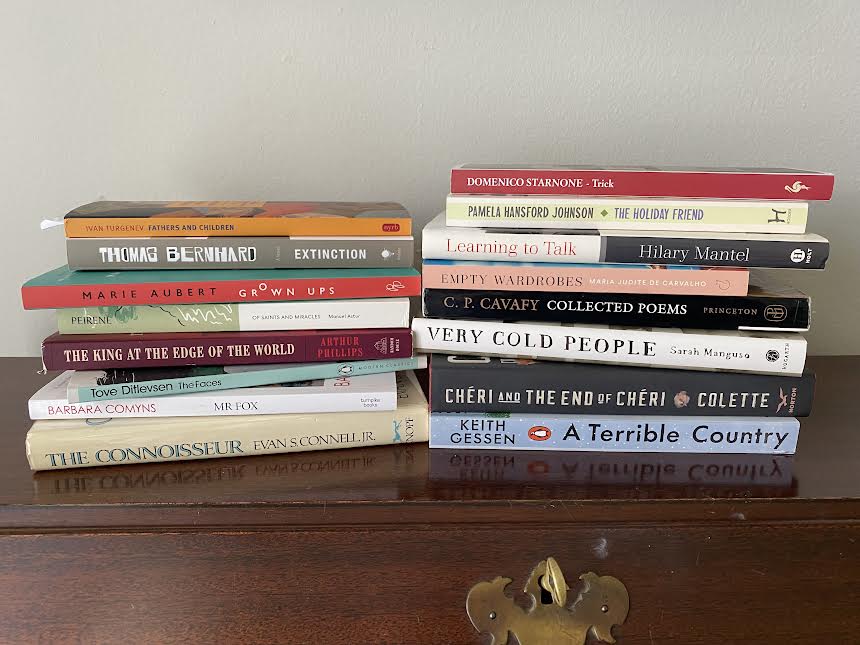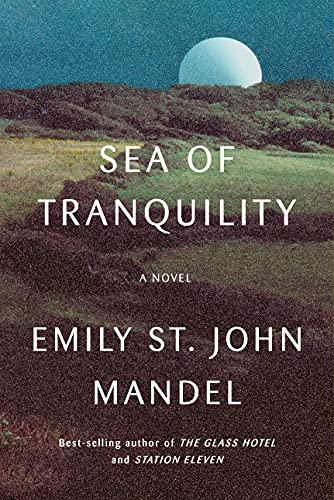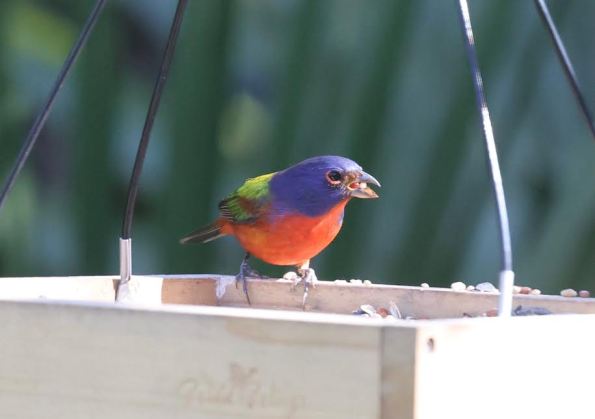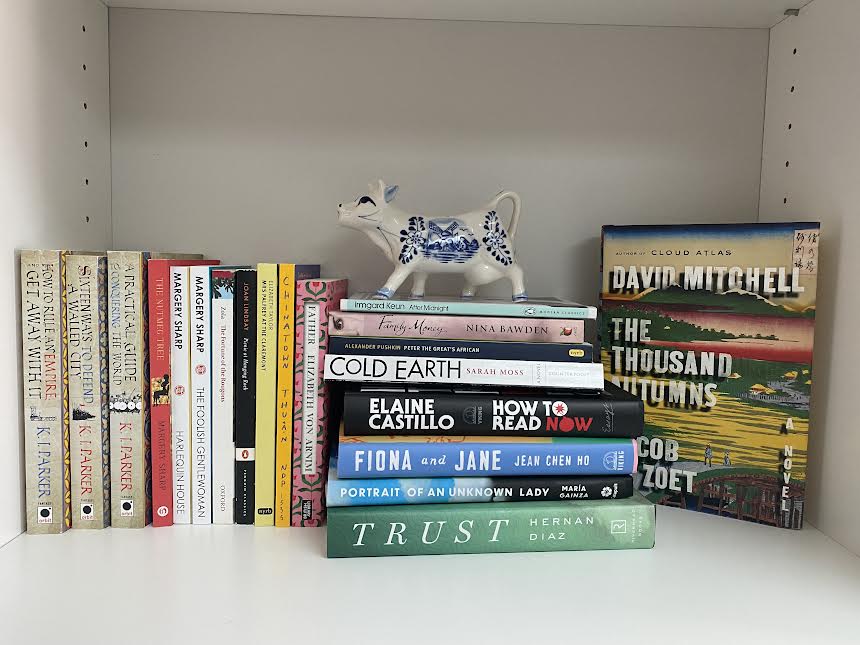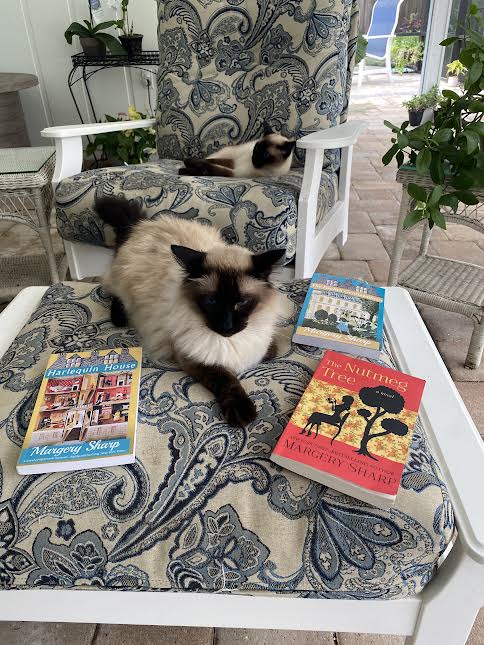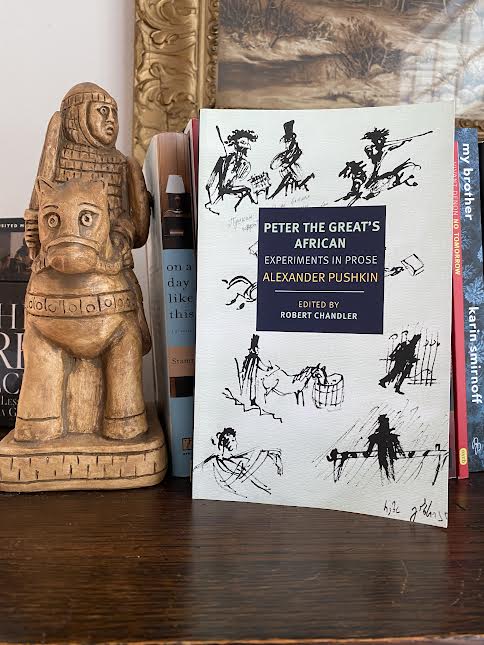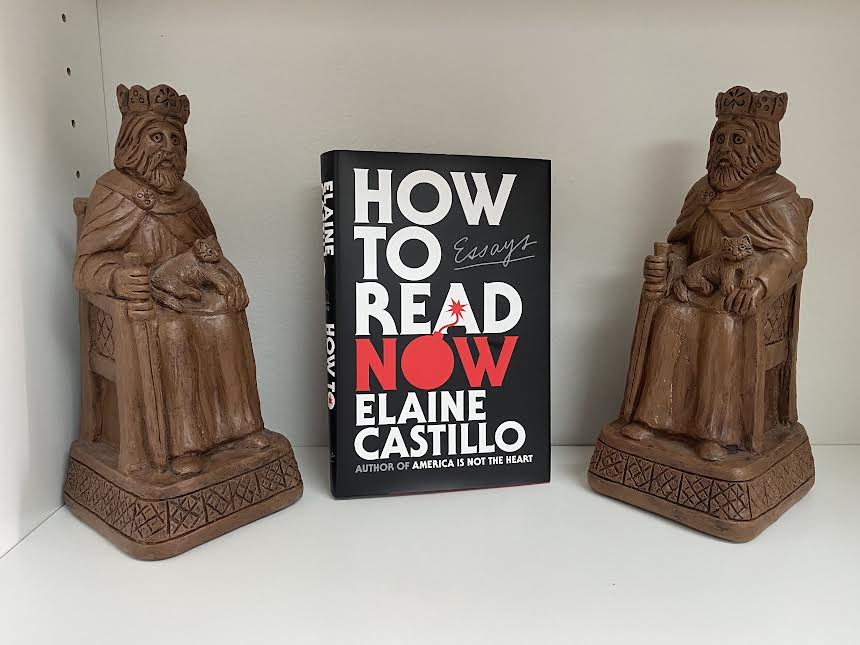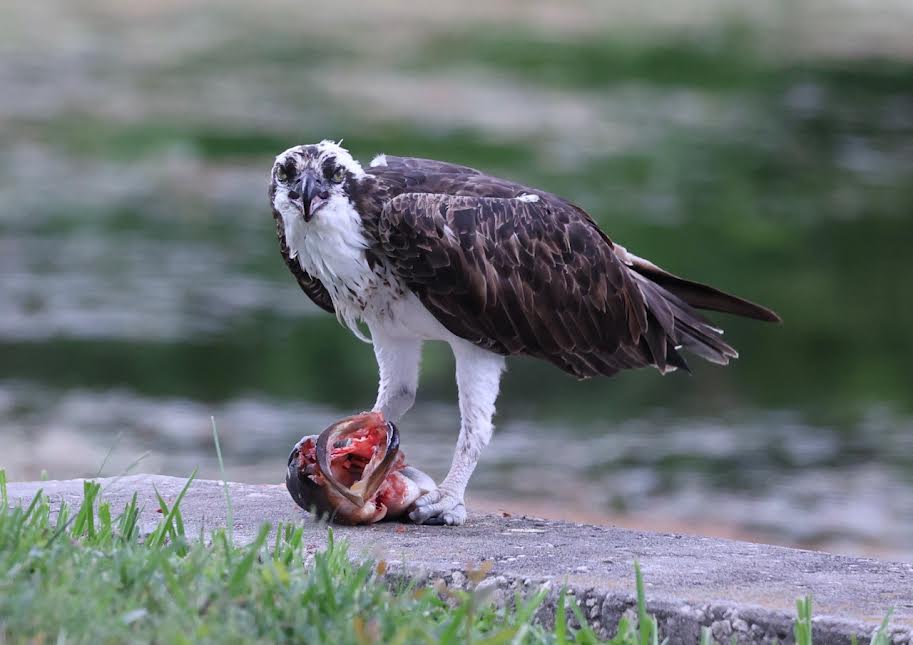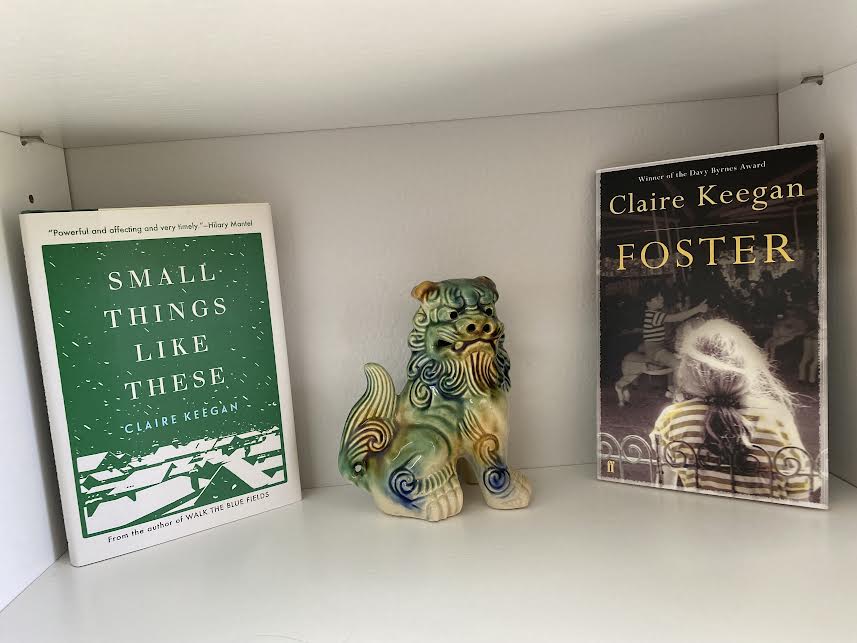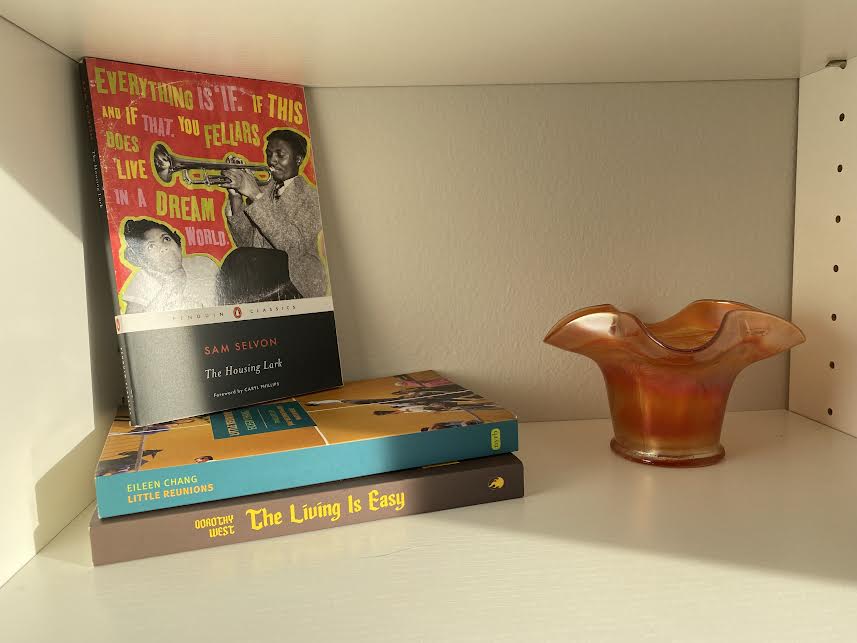
My heavens, dear readers! Can it possibly be early July? Is the year half-way over already? And me without a single review to my name for 2023? However could such a shameful state of affairs happen? Well . . .
The year did not begin for me on an auspicious note. Nothing wrong in a major way, but the New Year found me feeling a certain ennui that is generally rather foreign to my nature, especially when it comes to books. Have you ever had a period in which you struggled to read? That despite having piles and piles of lovely unread books, chosen with great excitement (and, in many cases, considerable expense), you just didn’t feel like reading any of them? This was precisely my mood as the new year rolled around. Despite an enormous TBR list that offered endless possibilities for new discoveries (not to mention fun), I’m afraid the beginning of 2023 found me in zombie mode as far as reading was concerned. Usually I love January, with its buzz of bookish Challenges; typically I spend several intensely pleasurable days pawing through my treasures and making totally unrealistic reading plans for the upcoming year. Not so this January! The arrival of 2023 saw me twiddling my thumbs, bored (actually bored) with my books and not even beginning a single new novel. Quelle horreur!
Despite this, I did manage to read a few things simply by powering through my malaise (not to be trendy, but I suppose you could say I leaned into it) — not reading much, by my standards; but reading. Like nursing an illness, I made reading easy on myself by picking only a few things by authors I had previously enjoyed. I also re-read several books or novellas I had liked or admired in the past and picked fiction heavy on character and stylistic elegance, the main features that attract me in novels. In short, I marked time until my reading mojo chose to reappear! By February, and the discovery of some truly great novels things were definitely looking up. Although I still didn’t feel like reviewing anything myself, I did resume reading some of your lovely blog posts and leaving a comment here and there. All in all, it was an incredible relief to find my bookish life ever so slowly returning to normal.
As far as posting was concerned, however, I’m afraid my recovery’s remained incomplete. As I suspect some of you know, it’s hard to get back into blogging after a break, particularly when other, very enjoyable activities are calling your name! Chief among these has been travel, as Mr. J. and I have slowly emerged from our covid cocoon, dusted off our passports and resumed our (very) mild wanderings on the earth. I’ve also been spending much more energy & time on art history and nature , centering the travel when possible on these long-time hobbies of mine (Bernini’s David! The Ghent altarpiece! The Iiwi!) Loads of fun, but definitely not conductive to keeping the blog current! (When I do Part II of this Post, hopefully in a few days, I may throw in some of Mr. J’s excellent photos. Other than that, I won’t bore you with details).
But enough of the mea culpa — time to talk about books! Even in low energy times I generally keep a sort of running list of the books I’ve read. This year, contrary to my usual practice, my list has actually morphed into a hybrid between a list and a journal, as it frequently included my brief impressions/assessments of what I was reading as well as how it slotted into my life at the time I was reading it. Working from this, I decided to post an overview of my 2023 reading as this seemed the least painful way to ease myself back into blogging. While I’ve retained my journal’s chronological format & style, I’ve done some mild editing & expanded several entries to reflect additional thoughts about certain books that I found particularly interesting. TBH, dear readers, the whole thing is a bit of a hodgepodge, but I’ve thrown in some photos & headings that should make it easier for you to navigate to particular items you might find interesting, or to click away from those that you don’t. I’ve also resisted the temptation to leave out some of my (ahem!) “lighter” choices. After all, I can’t be the only one out there who loves Georgette Heyer, pulp sci-fi of a certain vintage and the occasional chick lit best seller, can I?
JANUARY 2023: STRUGGLING THROUGH SLUMP MONTH
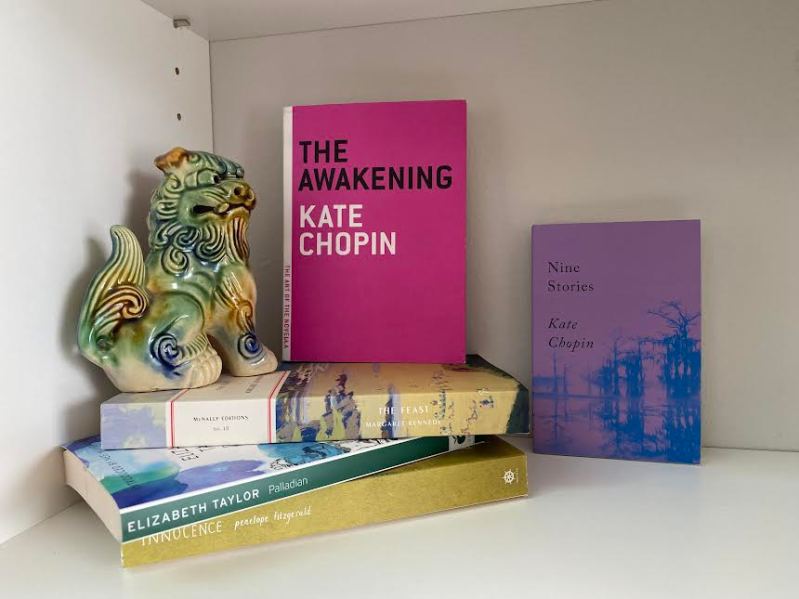
I began the New Year with a re-read of Kate Chopin’s The Awakening, whose novella length and status as a re-read made it a perfect beginning for my apathetic, low energy month. Chopin’s Louisiana setting was an additional attraction; I lived in New Orleans many years ago, loved the place and felt in the mood to revisit the city through the eyes of Edna Pontellier, Chopin’s protagonist. I was also interested in comparing my present reaction to the novel to that when I first encountered it many years ago. The first time around (before I lived in New Orleans, I might add) I’d literally raced through Awakening; to my shame, I was mostly relieved to cross it off my list and move on to the next newly discovered feminist classic. In other words, I’d liked it in a rather mild kind of way but wasn’t particularly impressed. What a difference a second reading can make, particularly when it comes so much later in life! This time I savored practically every phrase, awed by Chopin’s skill with the language and her boldness in depicting the limitations of the world inhabited by her protagonist, trapped in her beautiful doll house and meaningless life. Chopin’s beautiful style, her ability to create atmosphere and her sheer honesty about, and insight into, her Edna’s psychology are leagues beyond what so many of her contemporaries were churning out. How could such a marvelous writer have been so thoroughly forgotten for so long?
WILL ONE OF MY FAVORITE AUTHORS BREAK THROUGH MY JANUARY ENNUI?

I Was delighted when Cathy746 announced a year of “Reading William Trevor,” as it reminded me of how very much I love his work. Surely reading something, anything, from such an old favorite, a master of style and psychology, would restore my reading enthusiasm! Sad to say, my remedy failed. No reflection on William, he remains as great as ever in my estimation, but even his considerable literary power wasn’t enough to break through my apathy, particularly when the latter was combined with a truly nasty, late January sinus infection. I wanted to save Felicia’s Journey and After Rain, two of my all time favorites, for happier times, wasn’t in the mood for short stories (so difficult to decide which to read first, n’est-ce pas?) and didn’t have the energy to embark on a totally new novel. After a certain amount of apathetic dithering about, I returned to two Trevor works that I’d first read decades ago. I picked these two because I’d liked both very much but remembered very little about the plot of either.
I began with Two Lives, which contains two separate and seemingly unrelated novellas under one cover. The novellas are a study in contrast — as each explores two very different protagonists — are set in wildly different locales and strike very different emotional chords. My House In Umbria begins with the reminiscences of Mrs. Emily Delahunty, now retired from her career as a lady of pleasure in colonial Africa to the serenity of the Italian countryside (as Mrs. Delahunty explains early on, she’s used many different names over the years and the “Mrs.” is a courtesy title; “strictly speaking” she’s never been married). Ensconced in a charming Umbrian villa, and ably assisted by her rather sinister factotum Quinty (one of Trevor’s great minor characters) she occasionally assists the local hotels when they’re overbooked by taking guests at her villa. Mostly, however, Mrs. Delahunty spends her days writing florid and very successful romance novels. All goes reasonably well until, suffering from writer’s block (she’s unable to flesh out her new novel, tentatively titled “Ceaseless Tears”) & looking for inspiration, Mrs. Delahunty boards the wrong train at the wrong time. After surviving the ensuing terrorist attack that kills many of her fellow passengers, she impulsively and generously offers accommodation at her villa to the survivors (Quinty, less generous, ensures that the lodging isn’t free). The heart of the novella concerns both the complex relationships that develop among the survivors as well as Mrs. Delahunty’s past, which Trevor gives to us in funny, heart-breaking and oh-so-realistic fragments, in a way that only he can do.
In contrast to the exotic Mrs. Delahunty and her Umbrian menagerie, Mary Louise Dallon of Reading Turgenev is a much less colorful and seemingly more tragic protagonist. Mary Louise is the younger daughter of poor farmers who “struggled * * * to keep their heads above water” (page 4) in the dwindling Protestant community of a small Irish hamlet in the mid-1950s. Realizing that her dream of being a shop assistant in town is unobtainable, Mary Louise makes a marriage of convenience to a much older man (a naive thirty-five to her naive twenty-one) who’s one of the few Protestant bachelors in her community. After enduring years of a loveless and miserable-to-both-parties marriage, Mary Louise secretly begins to visit her invalid cousin Robert, whom she had not seen since childhood. During these surreptitious visits, Robert exposes Mary Louise to the literature and poetry, particularly the works of Turgenev, which had been the solace and comfort of his restricted and lonely life. As the two bond, Mary Louise becomes aware through the fiction they read of a world that transcends her own grim existence and experiences, for the first time, the comfort of having another human being who listens and understands her as no one else has ever done. After Robert dies unexpectedly, Mary Louise fashions his memory into an image of the great love that she believes they were destined to share. Her iron determination to own this memory, to keep and shape it for herself, insulates her from the assaults of her quotidian life and leads to tragic results. Or — does it? It’s part of Trevor’s greatness that he doesn’t leave the reader with an easy answer to this question.
When I first encountered Mrs. Delahunty and Mary Louise oh, so many years ago, it didn’t occur to me to ask the the obvious question of why Trevor paired these two novellas (Readers, I was quite young at the time!). Particularly with a novelist to whom character is so important, their juxtaposition suggests linkages between the two very different protagonists and their worlds. Using contrasts to heighten differences is an obvious and very old trick; it also seems an insufficient reason to pair these two novellas for a writer as subtle as Trevor. To me, the two lives, so very different on the surface, are actually quite alike in a very fundamental way. Despite their obvious differences, the paths taken by both women demonstrate the power of fiction and of the imagination in enabling us to transcend the mundane and often painful “realities” of our lives. Mrs. Delahunty, the product of a sordid past and unspeakable abuse, very consciously fashions sentimental stories with happy endings that allow her and her readers to escape, if only briefly, from their own lives into a reality that’s been shaped more to their likening. Mary Louise uses the literature she shared with Robert as a gateway to a world far removed from the horror of her daily life and as the foundation for fashioning her ideal of an eternal, transcendent love that she was destined to experience. Is the way these two very dissimilar women use art/literature a positive or negative thing? Trevor seems to suggest that it’s both.
It’s always interesting to re-read a work after a being away from it for many years; re-reading exposes lapses in memory, changes in sympathy and, occasionally, a greater appreciation of the writer’s craft. When I first read Two Lives, I preferred Umbria for its black humor and the clever way Trevor had Mrs. Delahunty unknowingly reveal so much about herself that she would have clearly preferred to keep private. I actually thought, first time around, that Turgenev was a bit boring, in a well written kind of way. My reaction on re-reading, however, was wildly different. Although I still enjoyed Umbria’s mix of irony, pathos & dark humor (it is very funny at times), this time around it was Turgenev that blew me away (irrelevant aside: Trevor was nominated for the Booker for this work but lost; how could that possibly be?). Last year (or was it the year before? too lazy, I’m afraid, to look it up), I read and very much enjoyed Claire Keegan’s Foster & Small Things Like These. Re-reading Turgenev reminded me very much of the tradition Claire Keegan is working in; her work is almost the equal of Trevor’s in its subtlety, psychological insight and craft. For me, there’s no greater praise.
Despite my renewed appreciation of Trevor, however, Two Lives failed to restore my joie de livre. Operating on the theory that, if one Trevor didn’t work, I might as well double down on a second, I went for a re-read of The Silence In The Garden. Again, I remembered little from my earlier encounter with this tale of decaying Anglo-Irish aristocrats in 1930s Ireland, haunted by something akin to blood guilt. Rich (perhaps a little too much so) in metaphors, Garden isn’t one of my favorite Trevor novels. Nevertheless, it’s a good story, beautifully written, and has some amazingly well-drawn characters (check out “Holy” Mullihan, a sadistic goon who’s a master in using religion to cloak his bullying). Second time through, I found Garden definitely worth the time, although I’d not place it at the top of my personal list of Trevor favorites.
WHERE DO I GO AFTER WILLIAM TREVOR?
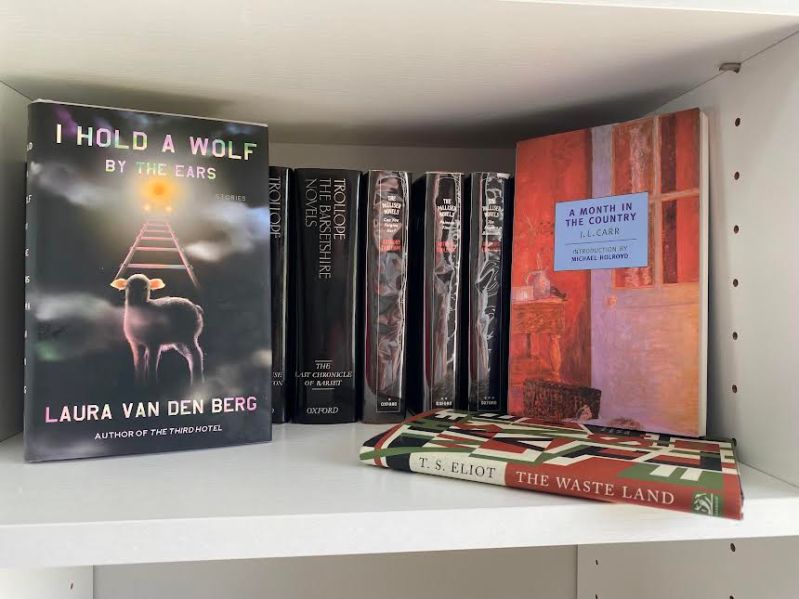
I first encountered Laura van den Berg almost a decade ago, when I read her short story “Opa-locka” in one of those “best of the year” anthologies. LVDB’s elegiac melancholy, combined with her ability to depict a reality that was just a bit off-kilter quite haunted me; she immediately won a spot on my reading radar and I resolved to check out more of her work. But — we all know what happens to those good intentions about our TBR list, don’t we? I would probably never have gotten to I Hold A Wolf By The Ears without the enthusiasm of my good friend Silvia, who read and loved this collection (thank you, Silvia!) As with any collection of short stories, I liked some more than others, but none was a dud. How to resist a writer who begins a story (“Last Night”) with the words “I want to tell you about the night I got hit by a train and I died”?
Still operating on reading autopilot, I cast about rather desperately for something short and undemanding to read. I settled on J.L. Carr’s A Month In The Country, which had been tempting me for a very, very long time. Did it live up to expectations? Well, yes and no. Despite my grumpy, listless mood I found it to be a lovely read. It was tinged with a most appealing nostalgia, with its protagonist’s remembrance, many years later, of events that would have altered his life had he acted differently. Carr is a wonderfully descriptive novelist; he made it very easy for me to visualize an English countryside in spring that I’ve never seen in reality. One aspect of the novel that I didn’t expect and that I found totally captivating was its underlying theme about the transcendent value of art and art’s endurance, despite its fragility, to the ravages of time. Despite all these good things, however, my attention did occasionally wander and I had to force myself just a teeny bit at times to continue reading. Although I could blame “the Slump” for my reservations, I don’t think I quite succumbed to the novella’s charms. Unfairly or not, I found Country perhaps just a bit too twee, its nostalgia a little too manipulatively pulling at the heart strings. Have any of you read it? If so, what did you think? Am I being a heartless curmudgeon or what?
January’s Discovery & Its February Continuation: I don’t read much poetry any more, so you can imagine my surprise when I unexpectedly became quite obsessed with Eliot’s The Wasteland. Could it be that sometimes only poetry will do? I was barely familiar with the poem, having read only a small portion of it several years back (and then only because it was required reading in a class I was taking) and had pretty much forgotten about it. For some reason, however, during a time when I was struggling to read even a novella, I became fascinated by Wasteland, which I read at least four or five times during my slump (assisted needless to say, by various cribs & guides as well as Eliot’s own very entertaining and idiosyncratic notes).
January’s “I Just Couldn’t Do It” Book:
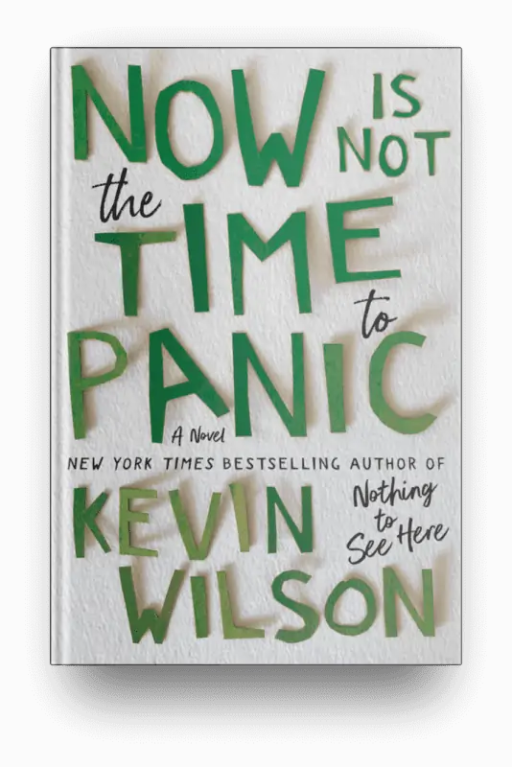
FEBRUARY 2023: A FALSE START THEN — BREAK THROUGH!
Despite reading some wonderful things the previous month, February saw my reading enthusiasm at its same tepid level. Clearly time to try a nuclear option, which in my case is the “Heyer (Georgette, that is) Cure.” Georgette has gotten me though many dismal times involving airports, long flights, minor illnesses and an unspeakably horrible camping trip (culminating in an unsuccessful attempt to see a Golden Backed Mountain Tanager ). If you’re a fan of Heyer’s work, you’ll understand my passionate devotion. If not, all I can say is you’re missing some of the best comedic dialogue since Bertie Wooster met Jeeves. I decided to skip some of my very favorite Heyers (Black Sheep; The Unknown Ajax and Bath Tangle) to focus on a couple of her (IMO at least) lesser Regency Romances. Still feeling rather dismal after a quick back-to-back of these minor gems (Sprig Muslin & Friday’s Child), I quickly added The Grand Sophy, one of Heyer’s very best, to my little binge read.
The result was disappointing; despite some temporary relief, the Heyer Cure failed to jolt my reading enthusiasm back to life. At this point, having nothing to lose, I decided to try something outside my comfort zone, which does not encompass works relating to 1930s Germany. Despite my general avoidance of the WWII era, however, I’d actually been quite excited a few months previously to discover McNally Editions’ reissuance of Lion Feuchtwanger’s The Oppermanns. Although I had put it aside for other things (at the time I hadn’t felt like beginning such a lengthy novel), its wonderful cover art and glowing reviews kept it on my reading radar. In a “what do I have to lose” mode (after all, I was already pretty bored), and with re-reads and gentle choices having failed me, I decided to give it a go. And the result? Bingo! Have you ever had that special feeling, when you know, just know, right from the opening pages, that the book you’re reading is just right for you at that moment in your life? Gentle readers, my mojo was back!
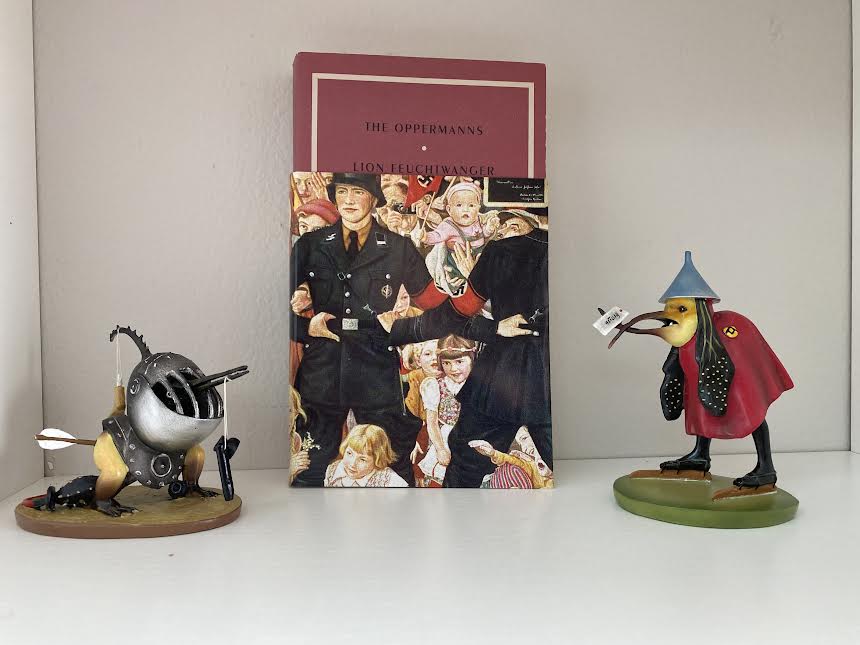
On its most superficial level, The Oppermanns recounts the destruction of a wealthy, assimilated family of German Jewish businessmen who have been loyal and patriotic citizens of the German state since the early 19th century. Among the mementos displayed in the family’s business office is one of their proudest treasures, a framed letter from Field Marshall von Moltke thanking Emmanuel, the founder of the family business, for his services during the Franco-Prussian War of the 1870s. When the novel opens, Emmanuel’s grandson Martin runs the family’s furniture business, known in Berlin for its quality goods and reasonable prices; his brother Edgar is a famous and successful doctor and Gustav, the third brother and the novel’s main POV character, is a devotee of the arts and a would-be literary biographer (a fourth brother, we learn late in the novel, perished fighting for Germany during WWI). Without reading too much into the text, it seems to me that the Oppermann brothers rather subtly embody the foundations of the German culture of their time, i.e., business, science and the arts, and their fates illustrate the decay of 1930s Germany and its vulnerability to the increasingly powerful Nazi movement. Rounding out the family picture is an Oppermann sister, who makes an occasional appearance, along with her astute & far-sighted husband, who’s regarded as not quite one of the family, being a native of eastern Europe rather than Berlin. The younger Oppermann generation is represented by Martin’s idealistic teenage son; Edgar’s daughter, who’s an increasingly passionate exponent of the Zionist movement; and Heinrich, the Oppermann brothers’ cautious and pragmatic nephew.
One of the things I particularly loved about the novel is its inclusion of characters outside the upper reaches of the wealthy and cultured haute bourgeois world in which the Oppermanns move. This opens out the story and conveys that what was happening affected an entire society and not just a rarefied and prosperous segment. Some of Feuchtwanger’s most interesting chapters (IMO at least) center on a clerk in the Oppermanns’ employment who lives in humble but contented circumstances; this ends when he runs afoul of an “Aryan” neighbor who covets his apartment. For all its length (my McNally edition clocks in at 368 pages, not counting a very helpful section of notes and a great intro by Joshua Cohen) the novel’s time frame is brief. It begins on Gustav’s fiftieth birthday in late 1932 and ends less than a year later, with the near-total destruction of the Oppermanns’ world.
Although it excels as a family saga, as well as a very realistic snapshot of a particular time and place, there’s a moral dimension to The Oppermanns that elevates it far beyond the story of individuals caught in the terrifying grip of history. Although I fear I’m mangling Joshua Cohen’s insights (his essay, if you’re interested, is available in the New York Times book review, link provided below), the novel in many ways is a meditation on identity and the testing of an individual’s character; the inhabitants of Feuchtwanger’s world, especially Gustav, question the purpose of their life and/or their duty to resist the evils of the time in which they live. In effect, Feuchtwanger asks whether one’s “work” is the completion of a literary biography (and by extension, participation in the arts); political involvement/resistance to the forces shaping one’s times; the perpetuation and survival of Jewish identity or, perhaps, self-reinvention and healing? At various times throughout his great work, Feuchtwanger suggests it is all of these things. It’s worth noting that Feuchtwanger himself had chosen to use his literary talents to serve his political beliefs, a decision for which he paid a high personal price. He wrote his novel in “real time” and about contemporary events, some of which he’d experienced at first hand (like his character Gustav, for example, Nazi goons ransacked Feuchtwanger’s house and destroyed valuable personal papers and drafts of his work). During the time in which he wrote Oppermanns, Feuchtwanger had fled Germany for life as an exile in England, been stripped of his German citizenship and seen his works banned by the Nazi party.
Although I’ve rattled on too long, I can’t leave this novel without a few words about the McNally edition shown in my photo (thanks again, Jacquiwine, for putting this publisher on my radar!). The publishing arm of the McNally Jackson bookstores in New York, McNally editions has a small but exciting list of “hidden gems” (quote & info, BTW, taken from the publisher’s website) which it reissues in beautifully produced paperback editions. Although I’m unsure of McNally’s distribution and availability, particularly outside the U.S., those of you in the U.K. with a yearning for Feuchtwanger need not despair, as Persephone has also published The Oppermanns (Book No. 136). I believe both publishers are using the same 1930 translation by James Cleugh; Joshua Cohen, however, has updated it and written a great introduction for McNally (note, however, that his NYT review is adapted from his introduction and is only a click away).
MY STREAK CONTINUES:
The only downside to reading a really great book is greed; having read something really, really good, you naturally want your next selection to be just as wonderful. And really, dear readers, how often does that happen? As if to counter balance those horrible reading weeks of early 2023, however, my next February selection was (almost) the equal of The Oppermanns.

Although I’d read and (mildly) enjoyed a Jane Gardam novel several years ago, I must admit that I had trouble understanding all the fuss about her work (the novel I’d read, in fact, left so little impression on me I’ve forgotten its title). I mean, her novel was o.k., I liked it, but I certainly didn’t rush out to read more. I did try Old Filth, supposedly one of her best, but didn’t get very far. Ditto for my second attempt; in fact, I may even have tried it a third time. Having ditched the Challenges this year, I decided 2023 was my “now or never” year for Gardam and I’m so glad I did! Where has this writer been my entire life? I not only raced through Old Filth, I quickly followed it with The Man In The Wooden Hat and Last Friends. Although I think there are some weaknesses, particularly in Last Friends, the trilogy is a wonderful achievement and easily one of the best things I’ve read in ages. Gardam, was, thankfully, a fairly prolific author so I’ve lots of catching up to do regarding her back list. Any recommendations?
February’s Orphan, Abandoned For No Good Reason:

MARCH 2023: Back To My Usual (If Slightly More Frantic) Pace
March was another travel month, with lots of airport time. Although I sometimes read serious stuff when I travel (I once finished Joseph Roth’s The Radetzky March during a single marathon flight), on the whole I tend to stick to mysteries or to more popular contemporary works. I’m a long time fan of Ruth Rendell’s dark psychological novels (originally published under her “Barbara Vine” pseudonym) and the presence of her work on my kindle dominated March, as I read four of her twisty, clever and psychologically acute novels at various points during the month (Judgment In Stone; A Dark-Adapted Eye; House of Stairs; & King Solomon’s Carpet). In a psychologically much lighter vein, I also read and enjoyed Jenny Jackson’s much ballyhooed Pineapple Street (so reassuring, dear readers, to discover that folks with thirty-seven million dollar trust funds need love too). Last, but far from least, was Deanna Raybourne’s tale of a squad of retired female assassins, Killers of a Certain Age; perfection itself for those with five-hour layovers in Kansas City.
One of my rare forays into non-fiction:

Some Of My Other March Reads:

Although I’m not rabid about it, I do tend to like Emma Donoghue’s work & have read several of her novels. She’s an eclectic writer; one of those rare artists who produces something different with each book. I purchased this one impulsively, on one of my milder book buying binges, and had no immediate plan to read it. By early March, however, my bookish mojo was up! Looking for something easy and contemporary, I started Haven pretty much on a whim and found it (surprise!) quite absorbing. It really helped to get into the mood by recalling a bleak arctic island or two I’d seen on some past birding trips, all rocky cliffs, wild ocean and seabird nesting colonies. Although I don’t think this was a great novel (or even one of Donoghue’s best), it was a quick and enjoyable read that, surprisingly, speaks directly to some very pressing contemporary issues.
After repeated and unsuccessful attempts to read Margaret Kennedy’s The Constant Nymph (unfairly or not, I just couldn’t get into the older man/nymphet thing), I decided to approach Kennedy through a different novel, The Feast (although it’s hard to tell from the photo, this is another of those adorable McNally editions). To my surprise, I loved it! So clever, to have the novel begin with an Anglican minister writing a funeral sermon, thereby ensuring the reader is hooked into guessing for whom the sermon is intended! Clever, well written and very funny at times, I’m now up for exploring more of Kennedy’s work. Who knows? perhaps I’ll even make it through The Constant Nymph!

March’s New Discovery:

March’s Trip Down Memory Lane:
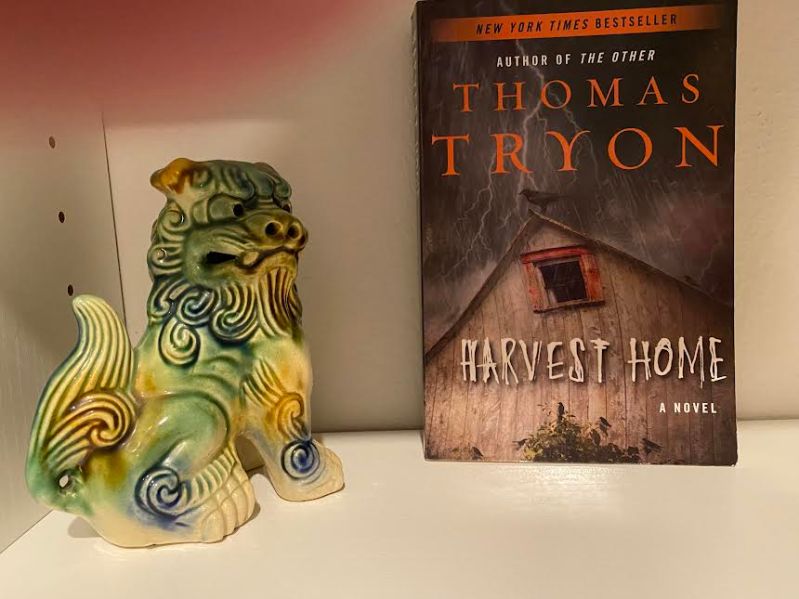
I’d read, and enjoyed, Harvest Home when it was first published aeons ago (in the 1970s, I think) but had largely forgotten it in the years since. During a recent browse through the NYRB Classics’ website (those flash sales! totally irresistible!), I came across The Other, perhaps Tryon’s best known novel, which I’d also read shortly after encountering Harvest, but not liked as much. Acting on sheer whim, I tracked down a replacement copy of Harvest (my original having been long since discarded) and settled in for a trip down memory lane. I must admit that, second time around, I found the writing rather clunky, the descriptions sometimes just a teeny bit hackneyed (there’s been a lot of literary fiction under my bridge in the intervening years) and the story at times rather gratuitously gruesome. But — Tryon can tell a story! With no intention of reading the whole thing, I quickly became immersed in his tale of rural dark doings and didn’t come up for air until I’d finished. The years, however, have definitely affected my opinion and not particularly for the better. In addition to noticing the stylistic defects that I’ve already mentioned, I also became a little uncomfortable at the sometimes not-so-latent misogyny that pervades the story. I’d have to know you personally, dear reader, to recommend this one, but for someone such as moi, with a taste for melodramatic trash horror and no demands for subtlety, this could prove a richly rewarding reading experience!
DIPPING INTO:

March’s “Just Couldn’t Do It” Books:

FINALLY (PAST TIME, DON’T YOU THINK?)
If you’re still with me at this point, you deserve (1) a medal for patience and (2) a little visual treat. I hope to be returning in a few days with Part II of my 2023 reading; meanwhile, I recommend you accept this advice from Zen Master Percy:

